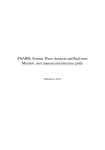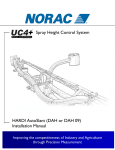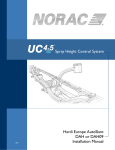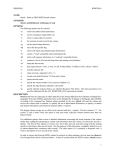Download the file
Transcript
8MR PUBLICATIONS COMPACI'US
(LENDING SECTION)
BUREAU OF MINERAL RESOURCES,
GEOLOGY AND GEOPHYSICS
RECORD
Record 1987/29
MAWSON GEOPHYSICAL OB5ERVATORY
ANNUAL REPORT,
1985
BY
P. J.
Iq8l/29
C~ ~'-l The inform8tion cont8ined
"
KELSEY
.
in this report he. been obt.lned by the Bure.u of Mlner.1 Resourc.., Geology .nd Geophysics ••
pert of the policy of the Auatr.UIIn Governmti\lt to ...i.t in the exploration .nd development of mlner.I resource• . It may not be
publl.hed in eny form or used In • compeny Pro.pectu. or .tatement without the permlnion in writing of the Director.
Record 1987/29
MAWSON GEOPHYSICAL OBSERVATORY
ANNUAL REPORT,
1985
BY
P. J. KELSEY
I I III
*R8702901*
\.
Contents
SUMMARY
1
INTRODUCTION
2
MAWSON GEOMAGNETIC OBSERVATORY
2.1 Absolute Instruments . . . . . .
2.2 La Cour Magnetograph . . . . . .
2.3 New Magnetic Variometer Building
2.4 New Magnetic Variometer System . . . . . . . .
2.5 Data from the New Magnetic Variometer System
2.6 Preliminary Data . . . .
2.7 Instrument Comparisons.
2.8 Rounds of Angles ..
3
4
2-1
2-2
2-4
2-6
2-10
. 2-11
. 2-11
. . . 2-11
SEISMOLOGICAL OBSERVATORY
3.1 Operation . . . . . . . . .
3.2 Radio Frequency Interference
3.3 Calibrations.
3.4 Data . . . . . . . . . . . .
3-4
CONTROL EQUIPMENT
4.1 Power Supplies
4.2 Timing Control
4.3 Cables . . . .
4-1
4-2
4-2
5
BUILDINGS AND BUILDING MAINTENANCE
6
OTHER DUTIES
3-1
3-2
3-3
ACKNOWLEDGEMENTS
REFERENCES
APPENDIX A HISTORY OF INSTRUMENTATION UP TO 1985
APPENDIX B
QHM CALCULATIONS
APPENDIX C
DAVIS ABSOLUTE INSTRUMENT COMPARISONS
Q.
Contents
TABLES
1
2
3
4
5
6
7
8
9
10
11
12
13
14
15
16
17
18
19
20
21
22
STATION DATA FOR MAWSON 1985
MAGNETIC VARIOMETERS USED AT MAWSON DURING 1985
QHM RESIDUAL TORSION CORRECTIONS AT MAWSON, 1985
QHM INSTRUMENT DIFFERENCES
SUMMARY OF QHM COMPARISONS FOR 1983 - 1986
SCALE VALUE AND ORIENTATION COIL CONSTANTS, 1985
LA COUR MAGNETOGRAPH PARAMETERS, 1985
OBSERVED BASELINE VALUES FOR LA COUR MAGNETOGRAPH, 1985
DATA LOSSES FOR PEMS DURING DECEMBER 1985, JANUARY AND FEBRUARY 1986
EDAS, W+W AND ATTENUATION BOX SETTINGS
PEM CALIBRATION CURRENTS
PHOTO-ELECTRONIC MAGNETOGRAPH AND DORIC PARAMETERS
OBSERVED BASELINE VALUES FOR PEMS AND DORIC THERMOGRAPH
PRELIMINARY MEAN MONTHLY AND K-INDEX VALUES 1985/6
PRELIMINARY GEOMAGNETIC ANNUAL MEAN VALUES, 1975 - 1985
PRELIMINARY INSTRUMENT CORRECTIONS, 1985
INTERCOMPARISONS OF MAGNETOMETERS, MAWSON 1985/6
SEISMOGRAPH PARAMETERS, 1985
LPZ SEISMOGRAPH CALIBRATION, NOVEMBER 1985
SPZ SEISMOGRAPH CALIBRATION, JANUARY 1986
DAVIS INSTRUMENT COMPARISONS, FEBRUARY 1985
QHM 492 RESIDUAL TORSION CORRECTIONS, DAVIS FEBRUARY 1985
FIGURES
1
2
3
4
5
6
7
8
9
10
11
12
13
Mawson
New magnetic variometer building
Instrument room layout for the photo-electronic magnetograph system
Orientation marks in the northern instrument room
Cabling of PEMs, MNS2 and Doric temperature monitors
Back up power for the MCC-l and MNS2
Cabling of photo-electronic magnetograph system
Mawson seismic vault
Frequency response of filter from SPZ AR320 input, Mawson 1985
Mawson seismic system
LPZ Calibration Curve, Mawson, November 1985
SPZ Calibration Curve, Mawson, January 1986
Time-mark relay driver box circuit
~.
SUMMARY
The work described in this report was part of the Bureau of Mineral
Resources contribution to the 1985 Australian National Antarctic Research
Expedit"ions. This contribution consisted of continuous recording of global
seismic activity and the geomagnetic field at Mawson.
The geomagnetic field was recorded using a normal La Cour magnetograph
(r'ecording H, D and Z components photographically) until 12 December 1985; and
after that by Photo-Electronic Magnetometers (X, Y and Z components) connected to
an Edas digital recorder (magnetic cassette tapes) and a visual multichannel
recorder.
Seismic activity was recorded using a Benioff short-period vertical
seismograph, two Benioff short-period horizontal seismographs and a Press-Ewing
long-period vertical seismograph.
Preliminary magnetic data were forwarded monthly to BMR, Australia.
Preliminary seismic data were forwarded bi-weekly to the National Earthquake
Information Service (NElS) of the USGS at Denver, Colarado, via the Bureau of
Meteorology's Global Telecommunication System (GTS) and to all other Antarctic
geophysical stations.
CII/WTER 1:
INTRODUCTION
Mawson Geophys'ical Observatory is operated by the Bureau of Mineral
Resources (BMR), Division of Geophysics, as part of the Australian National
Antarctic Research Expeditions (ANARE) at Mawson, Australian Antarctic Territory.
Logistic support is provided by the Antarctic Division of the Department of
Science. Station details are listed in Table 1.
The geomagnetic observatory commenced operation in 1955 using the absolute
and magnetic variometer huts and a three-component La Cour magnetograph from
Heard Island (Oldham, 1957). Since then numerous instrument changes have taken
During the summer of 1984/85 the Department of Housing
place (see Appendix A).
and Constructi on bun t a new magnetic vari ometer buil di ng for the observatory.
This was completed in May 1985 and during the latter part of the year
Photo-Electronic Magnetometers were installed in the building. These finally
replaced the La Cour magnetograph on 12 December 1985.
Seismological observatory history of instrumentation is also included in
Appendix A. In February 1985, the Benioff short-period horizontal seismometers
were installed in the Cosray vault, where the Benioff short-period vertical and
the Press-Ewing long-period vertical seismometers were already operating (Figure
8). This completed the conversion from photographic to visual recording of the
seismic system.
The author arrived at Mawson on 06 February 1985 on the Icebird to replace
Peter Crosthwaite who departed after an extended changeover on 05 March 1985 on
the Icebird. The replacement geophysicist Rodney Hutchinson arrived on the Nella
Dan on 29 January 1986 and after another extended changeover the author departed
Mawson on 14 March 1986 on the Nella Dan.
Absolute instrument comparisons were done at Davis in February 1985, during
a stop-over visit on the way to Mawson.
Introduction
1-1
r;
c.mPTER 2:
MAWSON GEOMAGNETIC OBSERVATORY
During 1985 a new magnetic variometer system was installed at Mawson.
It
consisted of X, Y and Z component Photo-electronic Magnetometers (PEMs) and a
Proton Precession Magnetometer (PPM) with a noise-cancelling sensor.
These
instruments were installed in the new magnetic variometer building. The X and Y
PEMs used were those previously installed in the old variometer hut. The Z PEM
and the noise-cancelling sensor (to be used with an MNS2 PPM) were brought from
BMR, Canberra. The magnetic field data were recorded digitally on magnetic
cassettes by an Edas data logger, as well as visually on a W+W chart recorder.
The new variometer system commenced recording on 12 December 1985.
Previous to this a La Cour magnetograph was used to record photographically
the H, D and Z components of the geomagnetic field.
It operated in the old
variometer hut. Table 2 outlines the operating periods and locations of the
different variometers used at Mawson during 1985.
All published magnetic data from Mawson were derived from the La Cour
variometer until 12 December 1985. Subsequently they were derived from the PEM
system.
2.1
Absolute Instruments
The instruments used were QHM 300 (with thermometers 2143 and 1650), QHM 301
(thermometer 1416), QHM 302 (thermometer 1401), Askania Declinometer 630332,
Askania circle 611665, BMZ 62 (thermometer 2501) and Geometrics PPM G816/1024.
The QHMs were all used with the Askania circle 611665.
The QHMs gave few problems. However the QHM 300 thermometer 2143 was
difficult to read so it was replaced by thermometer 1650 on 19 March. Coincident
to this, the residual torsion of QHM 300 also changed (Table 3). For QHM 300
observations up until 19 March the mean residual torsion was -3.7 minutes of arc;
from 19 March onwards the mean residual torsion was 12.4 minutes of arc. Since
residual torsion was not allowed for in the QHM calculations (see Appendix 8)
this increase in residual torsion should have caused an instrument correction
change of +0.4 nT to QHM 300. This was not the case, an instrument correction
change of -4.3 nT was actually observed.
If this change in instrument correction of -4.3 nT for QHM 300 is in fact
real, it should be apparent in the QHM instument differences calculated through
baseline value determinations during the year. And also in the yearly instrument
comparisons done between QHM 300 and the travelling standards.
The instrument differences between QHMs 300 and 301 and QHMs 300 and 302 are
given in Table 4 for 1985 with and without the inclusion of the instrument
correction change for QHM 300. Also the QHM instrument differences for the
previous three years are included (Crosthwaite, 1986; Cechet, 1984; Silberstein,
1984). The 1985 values that allow for the QHM 300 instrument correction change
are more consistent and compare better to the values from previous years, than
the values that do not include this change.
Table 5 summarizes the yearly QHM instrument comparisions done over the past
3 years. In 1983, 1985 and 1986 the travelling standards for QHM comparison were
HTM 570704 and QHM 172, while in 1984 they were HTM 570704 and QHM 174. The HTM
Mawson Geomagnetic Observatory
2-1
b
570704/Q11M 300 compari sons confi rm a poss i bl e instrument correction change to QHM
300 of -4.3 nT while the data from QHM 172/QHM 300 comparisons do not.
The change in QHM 300 instrument correction is primarily due to the change
of thermometer. It would seem that either or both of the thermometers 2143 and
1650 do not have accurate cal ibrations. It was noted by Cechet and Crosthwaite
(Cechet, 1984; Crosthwaite, 1986) that thermometer 1416 (QHM 301) was
incons"istent with the other QHM thermometers. As the calibrations of most BMR
QHM thermometers are very dated, it is expected that instrument correction
discontinuities will occur should any of them be replaced.
All data derived from QHM 300 observations from 19 March 1985 onwards are
adjusted to allow for the change in its instrument correction.
The QHM 301 clamping mechanism is sticky and introduces nuisance vibrations
at the beginning of an observation.
Declinometer 630332 and BMZ 62 worked satisfactorily all year.
PPM G816/1024 proved not to be a reliable instrument in Antarctic
conditions. The connections to the sensor were replaced a couple of times and
the dry cell batteries were an inadequate power source. However, it was used
fairly successfully for total field observations until 15 November when it died
completely. Its repair was inhibited by lack of documentation.
2.2
La Cour Magnetograph
The La Cour Magnetograph was used to photographically record the H, D and Z
components of the geomagnetic field from 01 February to 12 December 1985 (Table
2). On 29 November 1985 the Z magnet of the La Cour was removed as it was to be
installed in the new Z PEM. Thus for this period, 29 November to 12 December
only the Hand 0 components of the field were recorded. Otherwise the La Cour
operated continuously except for the following periods of record loss:
1985 February
Apri 1
July
October
23
24
28
05
15
0600UT
1900UT
0550UT
1420UT
1140UT
-
25
25
29
08
- 15
0600UT
0250UT
0620UT
0850UT
1220UT
This was a total of 147.5 hours or 1.9% of the total recording period.
The primary reasons for data loss and the degradation of data quality were:
1. failure of station power supply
2. loose/intermittent connections in the power supply and timing circuits
(PPT-l and TMU-l)
3. overfixation of photographic records
The 0 timemark trace and the 0 reserve trace were missing from the La Cour
magnetograms all year. The Z reserve trace was apparent but very faint.
No
attempts were made to restore or improve these traces as previous geophysicists
had had no success when tackling this problem (Crosthwaite, 1986). Also very
little data were lost during magnetic storms. All other traces were considered
to be acceptable so no adjustments were required.
Mawson Geomagnetic Observatory
2-2
7
Blasting at the rock quarry site adjacent to the old variometer hut ceased
at the el1d of February 1985. The rock crusher and other plant were not removed.
No blast"ing was done "in the '85/'86 summer.
Orientation tests were not done on the La Cour as 1985 was its last year of
operation.
The labelling of Mawson La Cour magnetograms is misleading. Generally the
H, 0, Z and T stamps on a magnetogram have an arrow which indicates the direction
of increasing field or temperature. On Mawson La Cour magnetograms the arrows
indicate directions of increasing magnitude of geomagnetic field components.
However the stamps do not indicate that magnitudes are being considered. Thus
the D and Z labelling is incorrect as D and Z are both negative at Mawson.
2.2.1
Parallax Tests
Parallax tests were performed shortly before or after each set of absolute
observations for baseline value determination. This was done to allow the event
marks for the observations to be accurately transferred to the data traces using
a parallel rule.
There is a very small parallax between both the Hand Z traces and their
respective timemark traces.
In both cases the data trace is 0.1 mm or
0.3 minutes of time to the left of the corresponding timemark (i.e. the parallax
corrections are +0.3 minutes). As previously mentioned there is no D timemark
trace. Any other set of timemarks on the magnetogram could be used. The D trace
is not more than 1 mm or 3.0 minutes to the right of the corresponding H timemark
and not more than 1.7 mm or 5.0 minutes to the right of the corresponding Z
timemark (i.e. the parallax corrections for the D trace are -3.0 minutes using H
timemarks and -5.0 minutes using Z timemarks). These measurements are difficult
to do accurately as the Hand Z timemark traces are a long way from the 0 data
trace on the magnetogram.
2.2.2
Baseline Value Control
La Cour scale value observations were done approximately four times per
month. The constants for the scale value coils for the H, D and Z variometers
are listed in Table 6. During every scale value observation the calibration
current was monitored using a Fluke digital multimeter. The nominal calibration
currents used were 60 rnA for H, 40 rnA for D and 70 rnA for Z. The adopted scale
values are listed in Table 7.
The Hand D scale values compare well with those of 1984 (Crosthwaite,
1986). However there is a significant change in the Z scale value from 22.65 +/0.08 nT/mm in 1984 to 23.33 +/- 0.07 nT/mm in 1985. In January 1985 a blast in
the rock quarry adjacent to the old variometer hut dislodged the Z magnet from
its agate. The magnet and agate were thoroughly cleaned before the magnet was
replaced. The Z scale value change is attributed to this event. Note that the Z
temperature coefficient also changed (Table 7).
Absolute observations were performed about seven times per month. As the
geomagnetic field at Mawson is very active absolute observations were done during
periods of little magnetic activity and reasonable weather conditions.
This
meant that observations were not spread evenly throughout the month.
Mawson Geomagnetic Observatory
2-3
The observing schedule was:
PPM G816/1024, DEC 630332, QHM 300, DEC 630332, PPM G816/1024
La Cour baseline values are given in Table 8.
QHM calculations do not take into account residual torsion (see Appendix B).
QHM observations were corrected for declination variation using data from the X
and Y component PEMs until 24 June 1985. After that the declination corrections
were measured from La Cour magnetograms.
The H baseline value change on 19 March 1985 for baseline values derived
from QHM 300 data is a result of an instrument correction change to QHM 300.
Some drift was seen in all of the H, D and Z La Cour baseline values derived
during 1985. This is depicted as discrete baseline value changes on 13 May for H
and D and on 01 July for Z.
QHM 301 and 302 observations were included once per month. Even though the
La Cour H baseline values (Table 8) derived for each of the QHMs were fairly
consistent, it is recommended that in the future QHM 301/302 observations are
done as frequently as QHM 300 observations, as has been the practice in the past.
The BMZ 62 was the back-up absolute instrument for the PPM G816/1024 and was
used only once per month. As there is a large scatter in Z baseline values
(Table 8) derived from BMZ observations (a range of 30 nT in 1985), it may be
advisable that BMZ observations are done more often than once per month in the
future.
When the Z magnet was removed from the La Cour variometer on 29 November
1985 for installation in the new PEM system, the Hand D baseline values changed.
These baseline value changes were observed on the 29 November magnetogram.
However during the period 29 November to 12 December no absolute observations
were made as all effort was being used to complete the PEM installations as
quickly as possible.
Before the La Cour was dismantled and RTA'd in February
1986, several sets of absolute observations were done in order to calculate the H
and D baseline values for this period.
The temperatures of the Hand Z variometers were read every chart change and
before and after each set of absolute observations. These measurements were
related to scalings on the magnetograms and least squares analyses were used to
determine the temperature scale values. The adopted Hand Z temperature scale
values were then used to determine the baseline values. See Tables 7 and 8.
2.3
New Magnetic Variometer Building
During the 1984/85 summer the Department of Housing and Contruction (DHC)
commenced building the new magnetic variometer building in East Bay (see Figure
1). The building was satisfactorily completed by 04 May 1985, allowing the
installation of the PEM system to commence.
However the official handover of the building from DHC to the Antarctic
Division did not occur until 30 January 1986. This caused some data losses in
December 1985 and January 1986 (see Table 9), as the PEMs were operational by
this time. The data losses occurred when DHC built the external stairs (concrete
pouring can only be done during summer) and undertook remedial work inside the
building; and during the inspections required by DHC and the Antarctic Division.
The new magnetic variometer building consists of a cold porch,
Mawson Geomagnetic Observatory
2-4
a control
room and two instrument rooms (F'igure 2). The construction of the building is
quite elaborate.
The building consists of two independent, non-connecting
shells. The outer shell is bunt from panels which are a sandwich of polystyrene
between two layers of marine plywood and oregon studs. The panels of the inner
shell are similar except that the polystryrene is omitted. The panels are nailed
together using bronze nails. In the construction of both shells the panels were
connected using non-magnetic grade stainless-steel (316) bolts, and each shell
was anchored to the concrete slab using similar grade hold-down bolts.
The
concrete slab has non-magnetic grade stainless-steel reinforcing. The slab is
insulated from the ground except where it is keyed into the rock via 4 keyways
each 200mm square by 600mm deep.
The building is finished with fibreglass
capping and all external bolt heads are insulated.
A few points should be noted:
1. The escape hatch over the door is usel ess and unnecessary.
2. The electrical circuit board is grossly over-designed and complicated and
contributes to magnetic interference.
3. The electrical cabling g6es underneath the floor of the southern most
instrument room from where it enters the building to the electrical circuit
board (Figure 2).
4. An external socket was in the original plans to accomodate an external
generator to supply 240VAC to the building if mains power to the building
became unreliable or non-viable. As the probability of this happening was
negligible and an external power supply close to the building would cause
magnetic interference it was recommended that this socket not be installed.
The magnetic variometer building is nominally non-magnetic.
However,
ferrous materials are included in many components of the electrical circuit
board, ego the transformer (iron core), circuit breakers (bi-metallic, including
ferrous strips and springs), and the main switch (steel structure); and also in
In addition, some magnet
the door latches (parts of the internal mechanism).
interference originates from the transformer and relays in the electrical circuit
board. The purpose of these was for load shedding from the main power house
should station power consumption become critical. As the power consumption of
the new magnetic variometer building is quite small these relays and the
transformer were bypassed but not removed. Thus the transformer merely supplies
additional ferrous interference instead of a fluctuating magnetic interference.
Station power to the new magnetic variometer building arrives via Ring Main
Unit No. 4 (RMU-4). The data cable from Wombat follows the eXisting cable tray
to a point near RMU-4. A separate fire alarm cable was installed. All three
cables leave the cable tray near RMU-4 and are laid along the ground to the new
magnetic variometer building (see Figure 1). This route requires one road
crossing, which was installed by DHC, and skirts the rock quarry adjacent to the
old variometer hut. At the'time of inception the route was very safe from any
interference likely to cause damage to the cables.
Apart from its electrical design, the new magnetic variometer building is an
excellent building and should provide more than adequate housing for any
variometers BMR requires to operate at their Mawson Observatory. The level of
ferrous interference mentioned previously is quite acceptable in a variometer
building. However, when the Mawson Absolute Hut is replaced a building of
simpler design should be considered. A pre-fabricated, insulated fibreglass
shell bolted to a concrete slab would be very adequate. Besides greatly reducing
cost this would decrease possible sources of ferrous interference.
Mawson Geomagnetic Observatory
2-5
\0
2.4
New Magnetic Variometer System
Following the completion of the new magnetic variometer building, the
northern instrument room was prepared for the three-component (X, Y and Z) PEM
system and an MNS2 PPM. The X and Y PEMs were relocated from the old variometer
hut (see Table 2), the Z PEM was a new instrument from BMR, Canberra, and the PPM
was to be either the MNS2/l or the MNS2/2, used with a new noise-cancelling
sensor built by BMR. A doric temperature monitor (346904) was installed to
monitor the temperature of the instrument room.
Back-up DC power was
(MCC-l) of the PEM system.
installed for the MNS2 and the Magnetic Controller
The data were logged in the Science Building (Wombat) by a digital recorder
(an Edas unit utilizing a magnetic cassette drive) and a visual multichannel
chart recorder (W+W).
2.4.1
Preparation of Instrument Room
Layout of the Instrument Piers:
Tests were undertaken to determine the mlnlmum permissible separation
between the PPM noise-cancelling sensor and the PEMs. These tests were carried
out on the X and Y PEMs while they were operating in the old variometer hut. The
PPM noise-cancelling sensor affected the X PEM when the distance between the PPM
sensor and the helmholtz coils of the PEM was less than 790mm. The PPM affected
the Y PEM when this distance was less than 960mm. The closest spacing allowable
between adjacent PEM helmholtz coils is deemed to be 1000mm. The PEMs should be
arranged in a manner such that there is no light interference between them. PPMs
have stronger signal strengths if the sensor head is of the order of 2000mm above
the ground (Wienert, 1970).
All the above points were considered in the internal design of the northern
instrument room of the new magnetic variometer building which was to house the X,
Y and Z PEMs and the noise-cancelling sensor of the MNS2 PPM. No heights or
sizes were specified for the PEM piers so these were made to accomodate the slate
pier tops available at Mawson, to be reasonably stable and to be of a reasonable
height to work at during the PEM installations.
The final layout of the instrument piers allows the maximum possible spacing
between the instruments (see Figure 3). The closest distance between any of the
sensors is about 1340 mm between the X and Z PEMs. The separation of the PPM
sensor from the sensors of the X, Y and Z PEMs is approximately l800mm, 3900mm
and l680mm respectively.
The X and Y piers are both 300mm x 600mm. Their pier tops are 915mm x 380mm
x 49mm and ll15mm x 459mm x 49mm respectively. The heights of the X and Y piers
with their tops in place are both 845mm. The Z pier is 300mm x 450mm and its
pier top is 6l0mm x 458mm x 55mm. The height of the Z pier with its pier top in
place is 848mm. The three pier tops are pieces of slate previously used in the
old variometer hut or the old seismic hut. The F pier (for the PPM sensor) is
300mm x 300mm. The pier top is made from compressed cement (AC) sheet and is
347mm x 350mm x l7mm. The height of the F pier with the pier top in place is
l397mm.
Mawson Geomagnetic Observatory
2-6
\\
The piers are made of poured concrete with non-magnetic grade stainless
steel (316) re-inforcing.
In January 1986, whilst working on the PEM Z during a blizzard, noise
cOinciding with wind gusts was observed on the output of the PEM. This noise did
not appear to be of sufficient magnitude to affect the Edas recording.
Nevertheless future installations of this nature should consider using piers of
more solid and stable construction.
Orientation Marks for PEM alignment:
Two lengths of timber 70 mm x 30 mm were installed along each of the long
walls of the northern (PEM) instrument room to accomodate orientation marks for
the PEM alignment. The lengths of timber were mounted 52 mm to 58 mm off the
walls. Three pairs of orientation marks were installed (see Figure 4).
Brass
nails were used as the marks.
The marks were derived from marks Nl and Rl which define an azimuth of 131
49.2' (Crosthwaite, 1986) and are embedded into the concrete floor of the
building (see Figure 2). The line defined by the marks labelled 1 (see Figure 4)
is due north-south and has an error estimated to be +/- 0.05°. The line defined
by the marks labelled 2 is also due north-south and has an error estimated to be
+/- 0.06°. The line defined by the marks labelled 3 is 64° West.
0
However, since this is
between 04 May 1985 when it
retain this accuracy as the
marks Nl and Rl before they
2.4.2
a new building and some shrinkage was already evident
was completed and January 1986, these marks will not
building moves. These marks should be checked from
are used to check the PEM orientations.
Installation of PEMs, PPM and the Doric Temperature Monitor
The X, Y and Z PEMs and the noise-cancelling sensor of the PPM were
installed on their respective piers in the northern-most instrument room of the
The Doric temperature sensor was installed
magnetic variometer building.
adjacent to the Y PEM sensor and at about the same height as the magnet of the
QHM 291 in the Y PEM. The MCC-l, MNS2 and the Doric temperature monitor were
installed in the control room (see Figure 2).
The outputs of the MCC-l, MNS2 and Doric are fed into a crushing terminal
box which terminates the data cable from Wombat. A similar crushing terminal box
is used in Wombat to terminate the other end of the cable. Figure 5 shows the
cabling from the MCC-l, MNS2 and Doric in the variometer building to the Edas
data logger and the W+W chart recorder in Wombat.
Setting up of PEMs:
The physical alignment of the PEMs was carried out using the orientation
marks previously described. The total error in the alignment of the helmholtz
coils of the X and Y PEMs is estimated to be +/- 0.18°. This is well within the
acceptable +/- 0.25°.
The line defined by the orientation marks labelled 3 (64 West) was used to
align the Z PEM. The total alignment error of the Z PEM Helmholtz coils to this
line was not estimated. The Z PEM is required to be aligned to within 10° of
magnetic North. As the annual mean declination for Mawson for 1985 was 63 40.3'
west and has been changing at a rate of about 7' west per year for the past 10
years, this Z PEM alignment is quite adequate. The critical aspect of the Z PEM
alignment is that the feedback coils be horizontal.
0
0
Mawson Geomagnetic Observatory
2-7
Once the physical alignment of the PEMs was completed, the setting up
procedure in the Phulo-electronic Magnetometer manual (Seers and Black, 1984) was
followed.
There were errors in the manual relating to polarities of the magnetic field
components and to the directions of reflected light spot movement when scale
value, set gain or orientation currents are applied to the helmholtz coils. This
caused some confusion when the PEM set up procedure was first followed.
There
were also a few ambiguous sections in the manual and one of the crucial diagrams
was missing.
Hardware faults in the system included some mild
used in the Z PEM. The output pins of the circuit
connected in reverse at the plug JI on the PEM casing.
supplied only I minule scale value pulses instead of 2
steel nuts and bolts being
board of the Z PEM were
The three-component MCC-l
minute pulses.
Despite these setbacks the PEMs were finally installed satisfactorily.
Setting up of the PPM Noise-cancelling Head:
The PPM was orientated on the F pier such that the axes of the detection
coils are roughly perpendicular to the geomagnetic field vector.
Note that the
axes of the detection coils are perpendicular to the long axis of the cylindrical
case.
Temperature Control:
It was decided to use 10°C as the standard temperature of the new variometer
system. The building is heated in both instrument rooms by non-magnetic heaters
mounted on the walls about 200 mm from the floor.
The heaters both have
thermostats. However a temperature controller built by BMR was used to control
the heater in the PEM instrument room and maintain the room at 10°C.
2.4.3
DC Back-Up Power Supply
A 24 Volt DC power supply utilizing two lead acid batteries was installed in
the magnetic variometer building to supply back-up power to the MCC-l and the
MNS2; see Figure 6. The MNS2 Hewlett-Packard (HP) power supply was used to
charge the batteries.
When the back-up power system was installed it caused a lot of noise on the
MNS2 outputs. Diodes were included in the circuit to isolate the HP power
supply, MNS2 and the batteries. This solved the problem.
As the ventilation in the new magnetic variometer building is extremely poor
two completely sealed Exide Safeguard 30 Amphour 12V batteries were used in
preference to normal lead-acid batteries.
2.4.4
Data Acquisition System
The data acquisition system was located in Wombat and consisted of an Edas
digital recorder utilizing magnetic cassette drive and also a W+W visual
multichannel chart recorder.
The data were transmitted to the Edas and the W+W via an attenuation box
which allowed attenuation settings of fl or +10. The W+W and attenuation box
settings, and the Edas settings and input module types and ranges are included in
Mawson Geomagnetic Observatory
2-8
\~
.
Table 10.
2.4.5
Noise on the Data Signal Lines from the Variometer Building
Once the new variometer system was installed and operating the noise on the
Due to
data lines was examined and an optimal earthing arrangement considered.
the lack of moisture in the soil good earths are a rarity at Mawson. The main
switch board in the new variometer building is earthed back to the main power
house (the Blue BOx). An earth was taken from the main switch board in the
variometer building to the crushing terminal box which terminates the data cable
from Wombat. This was used to earth the shields of the data cable from Wombat
and the cables from the MCC-l.
Figure 7 depicts the layout of the variometer
system and the earthing of the various data cables. The shield of the data cable
between Wombat and the variometer building is not earthed at Wombat.
Taking an earth from the main switch board in the variometer building was
actually unnecessary. The MCC-l circuit board earth is connected to its chassis
and mains earth via its mains power cable. The shields of all MCC-l cables are
connected to circuit board earth. Thus an earth could have been obtained at the
crushing terminal box via the shield of the output data cable from the MCC-l.
However, the earth from the main switch board was used because it was considered
to be better than an earth via the MCC-l.
The noise on the Doric signal was unaffected by either the MNS2 or the PEMs
and was seen to be about 0.2 V peak-to-peak.
The PEM signals were unaffected by the operation of the MNS2. At the
termination box in the magnetic variometer hut the PEM signals displayed high
frequency noise of about 0.08 V peak-to-peak. The Z PEM also exhibited 0.4 V
peak-to-peak spikes at the chopper frequency of the LED superimposed on this.
The Z PEM was using a new temperature compensating circuit board while the X and
Y PEMs were using the older style circuit boards.
This chopper frequency
interference on the PEM output signal is a characteristic of the new circuit
boards.
The PEM signals at the Wombat termination box exhibited a similar level of
high frequency noise but with a 0.3 V peak-to-peak 50 Hz signal superimposed upon
this.
The MNS2 (FlOO's and FlO's) signals at the variometer building termination
box displayed high frequency noise of about 0.1 V peak-to-peak whether the PEMs
were off or on. At the Wombat termination box the MNS2 signals exhibited high
frequency noise of about the same magnitude when the PEMs were off but 50 Hz
0.3 V peak-to-peak noise was superimposed upon this when the PEMs were operating.
This made the MNS2 signal very similar to the PEM signals.
These noise levels were reported to H.Q. and the reply received indicated
that they were quite acceptable. The PEMs have an output sensitivity of 10mV/nT
and a resolution of better than 0.04 nT under ideal conditions (Seers and Black,
1984). In view of this, it is suggested that the noise on the data lines from
the new variometer building be examined and hopefully decreased.
2.4.6
MNS2 Proton Precession Magnetometers
The MNS2/2 was installed
operating while the PEMs were
situated in the control room.
pier in the instrument room.
in the new variometer hut in August and was
being installed.
The MNS2 electronics were
The noise-cancelling head was installed on the F
The cycling rate was altered to 15 seconds per
Mawson Geomagnetic Observatory
2-9
\~
cycle. The temperature of the head was monitored by attaching the spare Doric
(346901) sensor to the head. The temperature of the head was about 20°C when the
room was kept at about 10°C. Although no calibrations were done the MNS2/2
appeared to be working well, giving the expected output on the W+W chart recorder
until 23 November when it started giving spurious field values.
The PEM installations were completed and the new observatory operational
before the problem with the MNS2/2 was considered. The IPS electronic engineer
bench tested both the MNS2/1 and the MNS2/2. The MNS2/2 bench tested OK. The
MNS2/1 had a track open circuit on the IImost significant bit DV1 board. Once
this was repaired the MNS2/1 was also OK. The two PPMs were both tried with
cycling rates of 15 seconds per cycle and 60 seconds per cycle but spurious field
values were still
apparent.
This problem was left with the incoming
geophysicist.
11
During PEM installations the PPM MNS2/2 was operating. During the set up of
the X PEM some interference was seen on the X PEM voltage output at the PEM
circiut board. However this was not evident when all the instruments were
operating and the output voltage lines were checked at the termination box in the
control room of the variometer building.
2.5
Data from the New Magnetic Variometer System
The three-component PEM system was used to monitor the X, Y and Z components
of the geomagnetic field from 12 December 1985 onwards. PEM data up to the end
of February 1986 were analysed for this report.
Several data losses were
incurred during this period (Table 9).
2.5.1
X, Y and Z Baseline Value Control
Absolute observations were carried out with the same frequency and observing
schedule as was used for the La Cour baseline value control. Scale value tests
were made following each set of absolute observations. The constants for the
scale value coils of the X, Y and Z variometers are listed in Table 6. The scale
value calibration currents were checked once per month (Table 11). Preliminary
and adopted scale values for the X, Y and Z PEMs are given in Table 12. Baseline
values for the X, Y and Z PEMs are given in Table 13.
The scatter in the Z PEM baseline values was quite low when first operating
(standard deviation was 3.6 nT). However on 08 January 1986, the light in the
PEM room was inadverently turned on while the PEMs were operating. This did not
affect the X and Y PEMs but caused the Z PEM to start oscillating on its agates.
The Z PEM magnet vibrated itself to one side of its support.
It had to be
re-centered manually. This caused a Z baseline value shift as was expected, but
also the scatter in the Z baseline values increased (the standard deviation
increased to 13 nT). See Table 13.
On 30 January 1986, one of the new temperature compensating boards was
installed in the PEM Z by the incoming geophysicist, Rodney Hutchinson.
It was
installed to measure -Z instead of +Z. This was corrected on 24 February 1986.
For absolute observations done during this period the values of the Z ordinate
from the Edas data were reflected about the zero values of the Edas
(approximately 5000 counts). The Z PEM baseline values thus derived were very
scattered (standard deviation = 23 nT).
Temperature coefficients for the X, Y and Z PEMs were determined by a least
squares analysis of baseline value vs temperature data. See Table 12.
Mawson Geomagnetic Observatory
2-10
2.5.2
Temperature
b~seline
and scale values
The temperature of the PEMs was monitored using a Doric temperature monitor.
The sensor was mounted adjacent to the Y PEM.
Before and after absolute
observations the temperature of the Doric display was read. A least squares
analysis of these observed temperatures vs the corresponding Edas counts was used
to determine the temperature scale and baseline values. See Tables 12 and 13.
2.6
Preliminary Data
K-indices, prelimillary baseline values, scale values and preliminary monthly
mean values were transmitted monthly to BMR geomagnetism section, Canberra.
These data were derived from the La Cour variometer data until 12 December
1985, after that from the PEM data. K-indoices were calculated from Hand D
indices from the La Cour data and X and Y indices from the PEM data.
Adopted scale values and observed baseline values are shown in
12 and 13.
Preliminary monthly mean geomagnetic field values and
values are listed in Tables 14 and 15.
Preliminary instrument
applied to these data are listed in Table 16. K-indices are listed
2.7
Tables 7, 8,
annual mean
corrections
in Table 14.
Instrument Comparisons
In January/February 1986 the QH~l 300 was compared to the travell i ng
standards QHM 172 and HTM 570704 and the Dec 630332 was compared to the
travelling standard Dec 640505. The Askania circle 611665 was used with all
instruments.
During the comparisons the Edas sampled at 10 second intervals (usually a
1 minute sampling interval). Six sets of each of the Hand D comparisons were
done. These results are tabulated in Table 17.
2.8
Rounds of Angles
Rounds of angles from Pier A in the Absolute Hut were carried out on 15 and
18 January, and 08 March 1986. The Askania circle 611665 was used to observe the
relative azimuths of the three marks: 'BMR 1985/2', 'SOH' and 'Short Peg' (ref
Crosthwaite, 1986).
The average angle between 'BMR 1985/2' and 'SOH' was 330 11.1' which agrees
with Peter Crosthwaite's azimuths. The average angle between 'SOH' and 'Short
Peg' was 84° 20.1' (and the average angle between 'Short Peg' and 'BMR 1985/2'
was 2420 28.8').
As these three marks are all so close to Pier A it is recommended that a
mark be established on one of the islands in East Bay for future use.
Mawson Geomagnetic Observatory
2-11
\6
CHAPTER 3:
SEISMOLOGICAL OBSERVATORY
The Mawson seismic observatory consists of a four component seismograph
system, (see Table 1 for details of seismograph locations):
Vertical seismometers
a Press-Ewing long-period seismometer
a Benioff short-period seismometer
Horizontal seismometers
two Benioff short-period seismometers
During the February 1985 changeover the two horizontal seismometers were
installed in the Cosray vault where the two vertical seismometers were already
operating. The data were collected on Geotech hot-pen helicorders located in the
Science Building (Wombat).
See Table 18 for the seismograph parameters.
3.1
Operation
In June 1984 the Benioff short-period horizontal seismometers (SPE and SPN)
were removed from the Old Seismic Vault (where they had been operating and
recording on a Benioff three-drum photographic recorder) to the Cosray vault.
The Press-Ewing long-period vertical (LPZ) and the Benioff short-period vertical
(SPZ) seismometers were already operating in the Cosray vault. The vertical
seismometer outputs were being recorded on Geotech hot-pen helicorders located in
Wombat. During the February 1985 changeover the outgoing geophysicist, Peter
Crosthwaite, and the author installed the horizontal seismometers in the Cosray
vault (see Crosthwaite, 1986). To do this the SPZ seismometer was moved and the
two horizontal seismometers were installed adjacent to the LPZ seismometer on the
seismic platform, see Figure 8. Due to an oversight the spacings between the
seismometers are somewhat less than the stated acceptable requirements
(Press-Ewing manual).
No interference was evident during 1985 but it is
recommended that tests be done on the system to verify this.
The existing two Geotech helicorders in Wombat were converted to dual pen
operation. The SPZ and SPE were recorded on one helicorder with a recording
speed of 60 mm/min while the SPN and LPZ were recorded on the other helicorder
with a recording speed of 30 mm/min. The nominal record duration was 12 hours.
However one of the helicorders lasted less than 12 hours initially and just over
12 hours after its microswitch had been shifted. The lack of grace in these
record changes caused some small record losses during 1985.
Thus on 02 September the helicorders were converted back
operation (24 hour record duration) and only the SPZ and the
recorded. This situation persisted until February 1986 when
geophysicist Rodney Hutchinson, installed a third helicorder
components were again recorded.
to single pen
LPZ data were
the incoming
and all four
Besides the shifting of the SPZ seismometer, few changes were made to the
vertical seismograph system. The LPZ TAM-5 amplifier was left non-rackmounted as
previous attemps to rackmount it adjacent to the SPZ TAM-5 amplifier had caused
"cross-talk" between the SPZ and LPZ signals (see Crosthwaite, 1986). The active
Seismological Observatory
3-1
\1
50 Hz filter which was on the SPZ TAM-5 output was removed at the beginning of
the year. No evidence of 50 Hz was seen on the SPZ signal during the year.
There was also a filter on the SPZ input signal to the AR320.
This was
removed (on 23 April) as it initially was not connected correctly and when
connected correctly it did not improve the problems of radio frequency
interference that were occuring.
The frequency response of the filter was
determined (see Figure 9) in case it should be required in the future.
During the worst blizzard of the year (21 June) the LPZ seismometer
exhibited an extremely unstable output. The LPZ signal was disconnected from the
AR320 input to stop the helicorder pen from self-destructing. After the blizzard
had abated the signal was reconnected and the LPZ system behaved as normal. This
was the only time such an event occured during the year. The reason for this is
unknown but a bad connection or some other electrical problem seems the most
probable cause.
Many modifications were made to the Wombat end of the seismic system to help
reduce radio frequency interference. These will be described later. Also with
the advent of the 1986 geophysicist the Wombat end of the seismic systemwas
tidied up. New cable teminations were installed and the equipment in the rack
was re-shuffled.
However the remote end of the seismic system (Cosray vault) is very messy.
The rack containing the SPZ TAM-5 amplifier is inadequately documented.
The
non-rackmounted LPZ TAM-5 amplifier has no back-up power in case of mains power
failure. The SP horizontals and the LPZ do not have calibration pulses.
The
cabling around the room is extremely messy.
The short-period horizontal TAM-5
amplifiers are in a temporary rack built by Peter Crosthwaite (Crosthwaite,
1986). Thus it is recommended that the remote end of the seismic system be
completely upgraded: the layout of the seismometers should be assessed, the
pre-amplifiers should be adequately rackmounted, back-up power should be made
reliable, calibration pulses should be available on all seismometers and the
cabling should be tidied up and adequately shielded to inhibit any interference.
3.2
Radio Frequency Interference
Radio frequency interference was evident on the Mawson seismic records
during 1985. Many simple modifications were done to the seismic system to
overcome this problem.
Interference from routine radio transmissions from
VLV (Mawson Radio) was apparent, but the problem was greatly accentuated by the
ham operators.
The following modifications were made to the seismic system in Wombat (refer
to Figure 10):
1. Data inputs to AR320s: These were twisted pairs from the termination box of
the data cable from Cosray to the inputs of the AR320s (pins 1 and 2).
These were replaced by shielded two core cable. The shields of these cables
were connected to the shield of the data cable from Cosray, to the pin 9's
(commons) of the AR320 amplifier boards via a 0.01 microF capacitor and to
the chassis of the AR320s.
2. Time mark inputs to AR320s from the relay driver: The twisted pairs were
replaced by shielded two core cables. The shields were connected to the pin
9's (commons) of the AR320 amplifier boards via a 0.01 microF capacitor and
Seismological Observatory
3-2
to the chassis. A 0.1 microF capacitor was put across all time mark outputs
in the Relay Driver box. Cable shields were not connected at the Relay
Driver box. However, the circuit board earth of the Relay Driver circuit is
connected to the chassis of the Relay Driver box. This is connected to
mains earth via the CRO.
3. A 0.1 microF capacitor was put across the OV, 12V supply in the time mark
Relay Driver.
4. A 1.0 microF capacitor was put between the OV and the chassis of the clock
currently in use (ref. no. N-1). There is a 0.1 microF capacitor between
the OV and 24V input to the clock in the original clock wiring.
5. 0.1 microF capacitors were put across the OV, -12V and the OV, +12V back-up
power inputs to the AR320s, ie. across pins 4 and 5 and pins 3 and 4 of the
power supply board of the AR320s.
Internally there is a 4.7 microF
capacitor between the OV (circuit board earth or common) and the AR320
chassis.
6. A 0.1
microF capacitor was put across the output from the ac power
changeover relay box which supplies 240Vac from the inverter or the mains to
the helicorder.
The outputs from the AR320s to the helicorders are shielded two core cable;
the shields were not connected at the AR320s or the helicorders.
The modifications to the system were completed in early July and removed
almost all the interference from the seismographs.
3.3
Calibrations
The LPZ seismometer was calibrated in November 1985, see Table 19 and Figure
11. The seismometer mass used in the calibrations was 6.9 Kg (Press-Ewing
manual). Since the weight lift point for the test masses does not correspond to
the center-of-gravity of the mass/boom system of the seismometer, the distance of
the center-of-gravity of the mass/boom system to the pivot and the distance of
the weight lift point to the pivot must be known for accurate determination of
It is possible to make a rough
the calibration coil motor constant, G.
measurement of the distance from the weight lift point to the pivot, but the
distance of the center-of-gravity of the mass/boom system to the pivot is not
accurately known. A value of 308 mm was used (Silberstein, 1984; Crosthwaite,
1986). This value is not mentioned in the Press-Ewing manual and is the value
used for the long-period vertical seismometers in the Worldwide Standard
Seismograph Network.
To obtain accurate LPZ calibrations an accurate determination of G needs to
be made either by determining accurately the two distances mentioned above or by
some other method.
12.
The SPZ seismometer was calibrated in January 1986, see Table 20 and Figure
The short-period horizontal seismometers were not calibrated during 1985.
Seismological Observatory
3-3
3.4
Data
Seismological data were reported bi-weekly to the National Earthquake
Information Service (NElS) of the USGS at Denver, Colarado, via the Bureau of
Meteorology's Global Telecommunication System (GTS) and to all other Antarctic
geophysical stations.
Seismological Observatory
3-4
CHAPTER 4:
CONTROL EQUIPMENT
In 1985 the Time Mark Unit (TMU) , the Power and Timing Unit (PPT-l) and the
Timing Board were removed from operation. The Time Mark Relay Driver was
installed. An Invertech (Serial No. 1781) inverter and a new voltage stalilizer
were installed to supply frequency and voltage stabilized power to the
helicorders. A changeover relay allows switching to mains power if the inverter
fails.
The dc power system was re-organised and a dc distribution board
installed. Back-up dc power was supplied to the AR320 amplifiers.
4.1
Power Supplies
Station mains (240V ac) and two lead-acid battery systems supply power to
the seismic system. The AR320 amplifiers are powered by station mains with -12V,
0, +12V dc back-up power. The helicorders run off an Invertech inverter (240V
ac) with switching to station mains if the inverter fails.
The inverter is
powered by the -12V, 0, +12V battery system. The radio and SPZ calibrator are
also powered by this -12V, 0, +12V battery system. The primary power to the GED
clock is from station mains with the 0, 24V battery system supplying dc back-up
power. The Time Mark Relay Driver which supplies time-marks from the clock to
the AR320 amplifiers and the W+W chart recorder is powered from the clock (0,
+12V). This was initially designed with a 0, 12V external power supply but was
modfied to be powered from the clock (Figure 13).
Figure 10 illustrates the seismic system and the power supplies. If all the
instruments were "floating" (circuit board earth not connected to mains earth)
only one dc battery system would be required to supply the 0, 24V and -12V, 0,
+12V power to the system. The inverter, AR320 amplifiers, clock and radio are
all "floating". However in order to do time comparison between the clock and
radio pips the respective time signals are displayed on the CRO via the Time Mark
Relay Driver. This connects the OV (circuit board earth) of the Time Mark Relay
Driver to mains earth via the CROj hence the OV of the 0, +24V battery system to
mains earth. As demonstrated by the incoming 1986 geophysicist it is easy to
inadvertently earth the AR320 amplifiers (or any other component of the system).
If only one dc battery system was in operation this would cause one of the 12V
lead-acid batteries to be shorted out.
The seismometers in the cosray vault use station mains and a 12V dc power
system.
The W+W chart recorder uses station mains. The Edas uses station mains as
its primary power source and an internal battery on mains failure. However when
this battery back-up system was checked in January 1986 it was found to be
faulty, so was repaired and new batteries were installed.
The new variometer system (PEMs and MNS2) utilizes station mains power and a 24V
dc back-up power system (see Section 2.4.3) located in the new magnetic
variometer building.
Control Equipment
4-1
4.2
4.2.1
Timing Control
Time Signals
A new Labtronics
Ionospheric Prediction
an aerial just north
aerials to the east of
radio was installed at the beginning of 1985.
The
Service (IPS) supplied BMR with an antenna, initially from
of Wombat and later from a "V" antenna located on IPS
the station.
Generally VNG (Lyndhurst, Victoria) was used to provide accurate time
signals for comparison with the GED crystal oven clock. See Crosthwaite, 198~
Table 21 for available stations, frequency and propagation delays to Mawson.
4.2.2
GED Digital Crystal Oven Clock
A GED clock was
systems.
used to provide time marks to the seismic and magnetic
Two new GED clocks were brought from Canberra at the beginning of 1985.
Both of these were installed and kept operating. This was to facilitate the
introduction of the second clock to the system should the clock in use
malfunction. Both clocks ran satisfactorily all year.
The clock used to supply
the time marks was kept to within the required accuracy of 50 ms.
Time comparison between the clock and radio pips was done by displaying both
signals on a dual channel CRO (Crosthwaite, 1986).
The Time Mark Relay Driver (Figure 13) supplied a further amplifier stage to
the GED clock time mark output and supplied time signals from the clock to the
seismic system, the W+W chart recorder and the La Cour variometer.
4.3
Cables
With the advent of the new magnetic variometer system the cabling has become
much simpler. The cables currently in use are:
1. A 10 twisted pair shielded cable from the new Magnetic Variometer Building
to Wombat carrying magnetic information and control signals. The cable
route is discussed in Section 2.3. This cable was laid in 1985 and has one
join near the old Variometer Hut as it was laid in two pieces.
2. A 10 twisted pair shielded cable from the Cosray vault to Wombat carrying
seismic information and control signals. This cable was laid in 1984 and
has joins near the Pump House as it was damaged in 1984 and 1985.
3. The cable carrying 12V from the Cosrologist's office to the Cosray vault.
All the cable joins done in 1985 were soldered. This is much neater and
more reliable than Scotchlock crimping connectors. Aluminium foil bound with
wire was used to reconnect the cable shield. The completed joins were encased in
two layers of heavy duty heat shrink tubing. Because of the low temperatures, it
was necessary that all joins be done in a parially enclosed space - cold porch of
Variometer Hut, ute cab or tent.
Control Equipment
4-2
CHAPTER 5:
BUILDINGS AND BUILDING MAINTENANCE
The buildings used in the operation of the BMR observatories are:
1) Magnetic Absolute Hut
2) Old Magnetic Variometer Hut
3) New Magnetic Variometer Building
4) Micropulsations Building (or Variometer Power Supply Building)
5) Old Seismic Vault
6) Cosray Building
7) Wombat (Science Building)
Only minimal maintenance was done to the buildings in 1985. The Old
Variometer Hut is in poor condition and should be removed.
The Absolute Hut is
in fair condition considering its age (ex- Heard Island), and given the correct
The new Magnetic Variometer
maintenance would last for several more years.
Building is excellent.
In 1985 a short-circuit in the station mains power cable between the
Variometer Power Supply Building and the Old Variometer Hut became apparent.
When the station electrician repaired the cable he bypassed the Variometer Power
Supply Building so this building is of no further importance to BMR.
The Old Seismic Hut continued in its role as general store room and is very
useful, providing a place for the storage of RTA crates and other bulky items
which would be a nuisance in Wombat.
It will require painting in the near
furture.
The Cosray building
houses all of the
seismometers and a
preamplifier/calibration rack deep in its mine shaft, and a 12V power supply in
the office. Despite requests to the Antarctic Division carpentar a ceiling was
not installed in the seismic vault in 1985 but would still be a good idea in the
furture. A pump is also required to empty the sump in the shaft during the melt.
The Science Building or Wombat is externally in good condition. However,
the interior could be re-painted and some of the furniture upgraded to make it a
more comfortable working enviroment.
Wombat was still not connected to
site-services at the end of 1985.
Buildings and Building Maintenance
5-1
CHAPTER 6:
OTHER DUTIES
The author was sea-ice observer for 1985. This involved taking measurements
of the depth of the sea-ice either weekly or monthly at various sample points in
the Mawson area, and noting the formation and decay pattern of the ice. It also
involved at times, reconnaissance of the sea-ice to judge its safety regarding
travel and recreation.
The usual station duties were performed. This included one night per month
nightwatch, a couple of weeks of full time kitchen duties and Saturday afternoon
council duties (garbage disposal etc.). Volunteer cooking was also done to
enable the full time cook to go on field trips.
Other Duties
6-1
ACKNOWLEDGEMENTS
The author w'ishes to express her thanks to the Mawson 1985 wintering party for
their assistance and co-operation. In particular special thanks are due to Danny
O'Reilly, Tony Everett and the rest of the DHC crew for completing the new
magnetic variometer building as early in the year as possible, for their help in
fitting out the interior and for their excellent road crossing (for the data and
mains power cables) near RMU-4. Also special thanks are due to Mark Loveridge
for his help with electronic problems and assistance in performing the daily
routine during the author's absence; to John McIlwham for braving the blizzard
and changing the La Cour records, and to Grant Morrison and Gina Price for help
with the daily routine during the author's absence.
REFERENCES
Oldham, W.H., 1957 - Magnetic Work at Mawson Antarctica 1955/56.
Bureau of Mineral Resources, Australia, Record 1957/79.
Crosthwaite, Peter, 1986 - Mawson Geophysical Observatory Annual Report, 1984.
Bureau of Mineral Resources, Australia, Record 1986/12.
Cechet R.P., 1984 - Mawson Geophysical Observatory Annual Report, 1983.
Bureau of Mineral Resources, Australia, Record 1984/36.
Silberstein, R.P., 1984 - Mawson Geophysical Observatory Annual Report, 1982.
Bureau of Mineral Resources, Australia, Record 1984/35.
Wienert, K.A., 1970 - Notes on geomagnetic observatory and survey practice.
UNESCO 1970.
Seers, K.J. and Black G.W.,
1984 - Handbooks for MPE-l
Photo-electronic
Magnetometer (Horizontal), MPE-2 Photo-electronic Magnetometer (Vertical) and
MCC-l Magnetic Controller (2nd Edition).
Bureau of Mineral Resources, Australia, Record (not published).
Instrument Manual for the Model SV-282 Press-Ewing Vertical Seismometer.
United ElectroDynamics, Inc.
QHM The Quartz Horizontal-Force Magnetometer. User's Manual.
Danish Meteorological Institute, DK-2100 Copenhagen February 1978.
McGregor, P.M., 1967 - Notes on the Use of the QHM Magnetometer
Measurement of Horizontal Intensity and Declination.
Bureau of Minera7 Resources, Austra7ia, Record 1967/140.
Acknowledgements/References
in
the
APPENDIX A:
HISTORY OF
INSTRUI~[NTATION
UP TO 1985
A brief summary of the developement of Mawson Geophysical
terms of instrumentation until 1985 is presented below.
Observatory in
Geomagnetic
May 1955
Absolute instruments used for regular observations of H, D &
Z (Oldham, 1957).
Jul 1955
Cant i nuous
1957
I~ecordi
I1g commenced by three-component normal La
Cour magnetograph (Oldham, 1957).
Bar-fluxmeter magnetograph installed (Pinn, 1961).
Jan 1961
Three-component insensitive La Cour magnetograph installed
and recording commenced (Merrick, 1961).
Dec 1967
Bar-fluxmeter magnetograph withdrawn (Dent, 1971).
Sep 1968
Insensitive La Cour magnetograph converted to medium
sensitivity and renamed normal magnetograph. The normal La
Cour magnetograph was renamed sensitive magnetograph (Smith,
1971).
Feb 1975
15 mm/hr normal
(Hi 11, 1978).
Dec 1975
15 mm/hr sensitive recorder replaced by 20 mm/hr recorder.
Mar 1981
MNS2 proton precession magnetometer installed for absolute
measurements.
Aug 1982
La Cour sensitive magnetograph removed (Silberstein, 1984).
Jul 1983
Photo-electronic magnetometer
installed (Cechet, 1984).
Jul 1983
MNS2/1 proton precession
(Cechet, 1984).
May 1984
Digital recording of PEM X and Y component data began
(Crosthwaite, 1986).
Mar 1985
QHM 300 thermometer 2143 replaced by thermometer 1650.
Residual torsion of QHM 300 also changed. Total instrument
correction change to QHM 300 was -4.3 nT (Kelsey, in prep.).
Dec 1985
La Cour normal magnetograph ceased operation.
PEMs commenced operation (Kelsey, in prep.).
recorder replaced by 20 mm/hr recorder
(PEM)
X and Y components
magnetometer ceased operation
Appendices
A-I
X, Y and Z
Qb
Seoismologoical
Jul 1956
Three-component Leet- BOI umberg
recorder) installed.
sei smograph
(pen- and- i nk
1960
Three-component seismograph installed consisting of Benioff
seismometers (free period 1.0 s) and three- channel BMR
single drum recorder. Z galvanometer 0.2 s free period,
horizontal galvanometers free period 70 s (Merrick, 1961).
Feb 1963
BMR recordel~ )Oeplaced by Benioff 60 mm/min three- channel
recorder. 14 s free period horizontal galvanometers
installed (Black, 1965).
Sep 1970
14 s free period horizontal galvanomters replaced by
short-period (0.2 s) galvanometers (Robertson, 1972).
Dec 1973
Z seismometer transferred to vault beneath Cosray building
(Almond, 1975).
Apr 1977
1978
Transfer of Geophysics office, including power and timing to
Wombat (Science Building).
Recording of SP-N Benioff
(Petkovic, not published).
seismometer
discontinued
Jul 1981
Helicorder hot-pen recorder installed for SP-Z and LP-Z; and
SP-N Benioff restored.
Aug 1983
Four Teledyne-Geotech seismic amplifiers (AR320) installed
for connection to twin hot pen recorders (Cechet, 1984).
May 1984
Horizontal
seismometers and the Benioff
recorder disconnected (Crosthwaite, 1986).
Feb 1985
Hori zonta 1 sei smometers i nsta 11 ed in Cosray vault; output to
visual hot pen recorders in Wombat (Crosthwaite, 1986;
Kelsey, in prep.).
Appendices
A-2
photographic
APPENDIX B:
QHM CALCULATIONS
All QHM observations (preliminary and final) done with the La Cour
variometer operational (01 February - 12 December 1985) were calculated using the
following formula (QHM User's Manual).
Residual torsion corrections were not
Residual torsion
included (McGregor, 1967; Crosthwaite, 1986 (Appendix 0).
corrections for QHMs used at Mawson in 1985 are listed in Table 3.
log H = C + log n - log sin(pht) + cl.t - c2.H.cos(phi)
where H
C
n
phi
cl
t
c2
horizontal field strength
= main QHM constant
= number of whole turns of the QHM from the zero position
= mean deflection angle
= temperature coefficient
= mean value of temperature in the two deflected positions
= induction coefficient
=
Preliminary calculations of the routine QHM observations done in conjunction
with the PEMs and the H instrument comparisons done in January/February 1986 were
calculated on a HP15C desk calculator using the following formula which includes
the residual torsion correction:
log
1-1 =
C + log n - log sin(pll"i) + c1.t - c2.H.cos(phi) - log cos(b)
where b
= a + (phi+ - phi-)/2
= deviation due to residual torsion
a
phi+ = deflection angle when n positive
phi- = deflection angle when n negative
All these routine QHM calculations (12 December onwards) were later
recalculated on BMR's HPI000 computer using the formula (which includes the
residual torsion correction):
H = K.n / (l-kl.t).(I+k2.H.cos(phi».sin(phi).cos(b)
where K
kl
k2
= main QHM constant
= temperature coefficient
= induction coefficient
The QHM coefficients are given below
c
QHM
QHM
QHM
QHM
HTM
300
301
302
172
704
QHM 300
cl(xl0E-5)
c2{xl0E-10)
17.1
30
40
40
20
4.19467
4.21644
4.18696
4.20077
4.081045
18.4
17.0
11.3
K
kl(x10E-4)
k2(xl0E-9)
15655.61
3.94
6.91
17 .4
Appendices
B-1
APPENDIX
c:
DAVIS ABSOLUTE INSTRUMENT COMPARISONS
Dur<ing a stop-over visit at Davis
were done between the QHM 492, used
standards. A BMZ tripod was used as a
and simultaneous observations were made
in February 1985 instrument comparisons
to measure Hand 0 and the travelling
temporary pier south of the absolute hut
with the help of Pelham Williams.
One set of simultaneous" comparisons was done. The QHM 492 (circle 73) was
compared wHh QIIM 172 (circle 508813). The observing schedule was:
Set
HI
Absolute hut pier
QHM 172
QHM 492
BMZ tripod
QHM 492
QHM 172
This gave an instrument difference, QHM 172 - QHM 492 of 23 nT (0.00138H).
The station difference (Pier - Tripod) was -29 nT (0.00174H) (see Table 21). The
QHM calculations were done using a HP 15C calculator and include the correction
for residual torsion. Residual torsion corrections for all the QHM 492 Hand 0
observations are listed in Table 22.
Two sets of simultaneous 0 observations were done.
QHM 492 (circle 73) was
compared with Dec 640505 (circle 508813). The observing schedule was:
Set
Dl
02
Absolute hut pier
Dec 505
QHM 492
QHM 492
Dec 505
BMZ tripod
QHM 492
Dec 505
Dec 505
QHM 492
The calculations of the QHM declination observations allowed for the
residual torsion of the QHM fibre and the collimation angle of the magnet/mirror
assembly (McGregor, 1967). Thus complete OHM 492 observations were made in order
to measure the residual torsion (Table 22). The collimation angle was taken to
be -8'.
The two sets of
the QHM 492 exhibited
of 5.2 nT to observed
and pier differences
difference, Dec 505 Tripod was 13.0' East
0 observations did not produce consistent results.
Since
a residual torsion of 1 15.9' (equivalent to a correction
H value) in the first set of 0 comparisons, the instrument
were calculated from the second set only.
The instrument
QHM 492 was 1.1' East; and the station difference, Pier (Table 21).
0
The QHM observations took approximately 20 minutes as it was difficult to
get sufficient light into the OHMs when operating them on the BMZ tripod outside.
Comparisons of the Davis BMZ 115 with OHM 172 and Geometrics 1024 PPM were
also made.
However, the PPM gave incorrect F readings (probably tuned to the
wrong setting) so these observations were unusable.
Appendices
C-l
1
STATION DATA FOR MAWSON 1985
Magnetic Absolute Hut - Pier A (instrument level)
Geographic co-ordinates
Geomagnetic co-ordinates
Elevation (m)
Foundation
67°36'14.2"S 62°52'45.4"E
73.34°S
105.89°E (from DGRF 1980.0)
12
Precambrian Granite
Magnetic Variometer Building - NEW, Mark Nl
Geographic co-ordinates
Elevation (m)
Foundation
67°36'11.4"S 62°52'38.5"E
09
Precambrian Granite
Magnetic Variometer Building - OLD
Geographic co-ordinates
Foundation
67°36'13.0"S 62°52'38.5"E
Precambrian Granite
Cosray Building, Seismometer platform
Geographic co-ordinates
Elevation (m)
Foundation
67°36'16.6"S 62°52'16.6"E
17
Precambrian Granite
The co-ordinates of Pier A, Mark Nl and the Cosray building seismometer
platform were measured by Crosthwaite in 1984 using ISTS 51 as a
This reference is a satellite trig station
reference location.
positioned by the road near the Old Seismic Vault and the Bureau of
Meteorology buildings.
Its location is 67°36'04.95"S 62°52'23.66"E,
its height above mean sea level is 9.79m, and its spheroidal height is
39.37m.
The co-ordinates of all buildings were measured by Australian Survey
Office surveyors, and the WGS 72 co-ordinates provided by ASO agree
within 0.2" of latitude and longitude with the instrument pier
co-ordinat~s measured by Crosthwaite.
Elevations quoted are Height Above Mean Sea Level. The elevations of
Pier A, Mark N1 and the top of the Cosray shaft were measured relative
to ISTS 51. The quoted elevation of the seismometer platform assumes
the shaft to be 13m deep.
2
MAGNETIC VARIOMETERS USED AT MAWSON DURING 1985
Dates Operated
Magnetometer Location
Component
La Cour
H
old hut
D
old hut
Z
old hut
Comments
Feb 01 OOOOUT - Dec 12 0600UT De-commissioned and
RTA'd
Feb 01 OOOOUT - Dec 12 0600UT De-commissioned and
RTA'd
Feb 01 OOOOUT - Nov 29 0400UT Z magnet removed for
installation in the
3 component PEM
system
PEM (2 Component)
X
old hut
Y
old hut
PEM (3 Component)
X
new hut
3
Feb 01 OOOOUT - Jun 24 1417UT Removed for
re-installation in
the new hut
Feb 01 OOOOUT - Jun 24 1417UT Removed for
re-installation in
the new hut
Dec 12 0500UT onwards
Y
new hut
Dec 12 0500UT onwards
Z
new hut
Dec 12 0500UT onwards
QHM RESIDUAL TORSION CORRECTIONS AT MAWSON, 1985
Instrument
QHM 300
until Mar 19
Mar 19 onward
QHM 301
QHM 302
QHM 172
HTM 704
phi (0)
58.44
58.36
phi ( , ) de r i ved (')
difference alpha
- 6.6
22.5
63.53
-42.4
56.69
59.62
40.92
-12.4
14.1
0.1
- 3.7
12.4
-17.0
- 7.5
7.2
0.1
re sid ua1 tor s ion (nT)
correction
0.0
0.4
1.1
0.1
0.2
0.0
significant
'6\
4
OHM INSTRUMENT DIFFERENCES
1. QHM instrument differences assuming no change in QHM 300 instrument
correction:
Date
1985
Feb 01 - Feb 10
Feb 10 - Mar 18
Mar 19 - May 12
May 13 Nov 29
QHM 300 - QHM 301 QHM 300 - QHM 302
{nTl
{nTl
WEIGHTED MEAN:
RANGE:
0.1
1.0
0.4
5.8
-5.1
-3.4
-4.8
1.2
4.4
5.7
-0.3
6.3
No of observations
301,302
QHM 300
6
5
12
42
1
1
1
8
2. QHM instrument differences assuming a QHM 300 instrument correction
change of -4.3 nT on 19 March 1985:
Date
1985
Feb 01 - Feb 10
Feb 10 - May 12
May 13 - Nov 29
QHM 300 - QHM 301 QHM 300 - QHM 302
{nT}
{nTl
0.1
-1.4
1.5
-5.1
-6.3
-3.1
0.8
2.9
-3.9
3.2
WEIGHTED MEAN:
RANGE:
No of observations
301,302
QHM 300
6
17
42
1
2
8
3. QHM differences from 1984, 1983 and 1982:
Year
QHM 300 - QHM 301
{nTl
QHM 300 - QHM 302
Comments
{nTl
1984
1.7 +/- 0.6
1.7 +/- 1.6
-5.4 +/- 0.5
-4.7 +/- 1.8
1983
1.6
-5.4
1982
2.5
-2.7
From La Cour data
From PEM data
5
SUMMARY OF QHM COMPARISONS FOR 1983 - 1986
Date
Observer
Feb/Mar 1983
Feb 1984
Feb 1985
Feb 1986
Silberstein
Crosthwaite
Crosthwa ite
Kelsey
6
HTM 704 - QHM 300 QHM 172 - QHM 300
(nT)
(nT)
43
-5
-6.2
-3.9
40.9
41.0
-9.4
SCALE VALUE AND ORIENTATION COIL CONSTANTS, 1985
Component
Scale Value Constant
nT/rnA
Orientation Constant
nT/rnA
La Cour Magnetometers
H
D
Z
8.07
8.07
8.07
8.07
7.49
Photo-Electronic Magnetometers
X
8.03
Y
Z
7
LA COUR MAGNETOGRAPH PARAMETERS, 1985
Component
H
D
Z
Tz
Th
8.03
8.03
8.03
8.03
8.03
Preliminary
Scale Value
2l.3
2.44
22.8
1.73
2.48
nT/mm
'/mm
nT/mm
"C/mm
"C/mm
Preliminary
Temperature
Coefficient
Adopted
Scale Value
Adopted
Temperature
Coefficient
+0.8 nT/ "c
21.03 +/-0.26 nT/mm
2.42 +/-0.02 '/mm
23.33 +/-0.07 nT/mm
1.76
"C/mm
2.46
"C/mm
+0.6 nTrC
-1.0 nT/"C
0.0 nTrC
8
OBSERVED BASELINE VALUES FOR LA COUR MAGNETOGRAPH, 1985
Date
Baseline Values
(BLV)
No of absolute
observations
Remarks
used to
determine BLV
Horizontal Intensity {nT}
1985
Feb 01 OOUT - Feb 10 03UT
17406
17406
17411
+/- 2
6
17417
+/- 4
5
17421
+/- 3
12
17418
17423
+/- 4
+/- 4
2
2
17426
17420
17424
+/- 2
+/- 3
+/- 5
42
8
8
17406
+/- 2
22
Feb 10 03UT - Mar 19 OOUT
Mar 19 OOUT - May 13 OOUT
Feb 10 03UT - May 13 OOUT
May 13 OOUT - Nov 29 04UT
Nov 29 04UT - Dec 12 06UT
1
1
QHM
QHM
QHM
new
QHM
300
301
302
observer
300
*
QHM 300
new observer
QHM 301
QHM 302
drift
QHM 300
QHM 301
QHM 302
Z magnet
removed
QHM 300
Declination
1985
Feb 01 OOUT - May 13 OOUT -6t' 40.4' +/-0.6'
May 13 OOUT - Nov 29 04UT -61 39.9' +/-0.6'
Nov 29 04UT - Dec 12 06UT -61 40.7' +/-0.4'
0
0
48
102
19
**
drift
Z magnet
removed
Vertical Intensity from PPM G816/1024 Observations {nT)
1985
Feb 01 OOUT - Jul 01 OOUT -46182
Jul 01 OOUT - Nov 29 04UT -46186
+/- 5
+/- 4
55
37
Vertical Intensity from BMZ 62 Observations {nT}
1985
Feb 01 OOUT - Nov 29 04UT
-46161
+/- 10
22
new PPM
drift
Temperature - Vertical Thermograph (DC)
1985
Feb 01
Feb 25
Apr 30
Jun 07
OOUT
OOUT
OOUT
OOUT
-
Feb
Apr
Jun
Nov
25
30
07
29
OOUT
OOUT
OOUT
04UT
-103.5
-103.7
-104.0
-103.6
Temperature - Horizontal Thermograph
1985
Feb 01 OOUT - Oct 28 OOUT
Oct 28 OOUT - Dec 12 06UT
+/+/+/+/-
0.2
0.2
0.2
0.2
24
64
38
175
drift
drift
drift
269
46
drift
(~C)
- 37.39 +/-0.04
- 36.91 +/-0.06
* The H BLV determined from QHM 300 observations changed on 19
March 1985 due to an instrument correction change to QHM 300. This
change was estimated to be -4.3 nT from this BLV shift.
** Even though there was a new observer doing the absolute
observations from 10 February 1985, the D BLVs matched exactly once
Peter Crosthwaite's were corrected by +1.2' West (see Crosthwaite,
1986).
9
DATA LOSSES FOR PEMS DURING DECEMBER 1985, JANUARY AND FEBRUARY 1986
PEMs commenced operating on 12 December 1985 0500UT.
Period of Data Loss
1985
Dec 22 1020 UT - 1444 UT
Dec 24 0900 UT - 1000 UT
1985
1986
Dec 28 0200 UT - Jan 03 1200 UT
1985
Dec 30 0330UT - Dec 31 0500 UT
1986
1986
Jan 06 0427 UT - Jan 08 1413 UT
Jan 30 0219 UT - 1058 UT
Feb 04 2019 UT - Feb 05 1129 UT
Feb 11 0332 UT - 1703 UT
Feb 24 0358 UT - Feb 24 0614 UT
Reason
Fixing MCC-1
Working in new magnetic variometer
building control room - ferrous
interference
DHC installing steps outside
magnetic variometer building ferrous interference
DHC inspecting interior of building
DHC doing remedial work to the
magnetic variometer building
Installation of new PEM Z circuit
board and official handover of
magnetic variometer building
Drive spring in Edas broken
Rod re-arranging instrument racks in
Wombat
Corrected polarity of PEM Z
10
EDAS, W+W AND ATTENUATION BOX SETTINGS
December 1985, January and February 1986
Edas Input Module
Edas and W+W Component Sensor Attenuation W+W
Box Setting Settings
Range
Channel
Ty~e
1
2
X
3
Y
Z
4
5
6
F(0-990)
F(0-99)
T
PEM
PEM
PEM
MNS2
MNS2
Doric
.;. 10
+ 10
. dO
+10 *
+10 *
+1
2 VFS
2 VFS
2 VFS
2 VFS
2 VFS
2,10 VFS **
2
2
2
1
1
2
+/-10V
+/-10V
+/ -10V
0-20V
0-20V
+/-10V
* This was 1 on some records.
** W+W setting was changed from 2 VFS to 10 VFS on 31 January 1986 0805UT.
PEM CALIBRATION CURRENTS
11
MCC-l Setting
4
8
20
40
80
rnA
rnA
rnA
rnA
rnA
Positive Current
4.1
8.0
19.8
39.8
79.6
mA
rnA
mA
rnA
rnA
Negative Current
- 4.1
- 8.0
-19.7
-39.6
-77.8
rnA
rnA
rnA
rnA
rnA
12
PHOTO-ELECTRONIC MAGNETOGRAPH AND DORIC PARAMETERS
December 1985, January and February 1986
Component
X
Y
Z
T
Preliminary
Scale Value
Edas
nT/count
w+w
nT/mm
nT;oC
0.1968
8.88
3.1
0.1986
0.1986
8.74
8.65
3.1
3.1
0.2065
8.88
- 8.0
0.1990
0.1990
8.78
8.71
- 8.0
- 8.0
0.2
8.92
-14.05
0.1950
0.1950
8.72
8.G7
-14.05
- 5.54
'>C/count
°C/mm
1985
December
1986
January
February
1985
December
1986
January
February
1985
December
1986
January
February
1985
December
1986
January
February
0.0205
0.0205
0.065 **
0.3738
Adopted
Scale value
Edas
nT/count
0.198
0.198
0.194
+/-.003
+/-.002
+/- .003
°C/count
T
*
0.0736
Component
X
Y
Z
Preliminary
Temperature Coefficient
0.0206
Adopted
Temperature Coefficient
W+W
nT/mm
8.68
8.74
8.70
°C/mm
nT;oC
2.45
- 6.35
-12.94 until Jan 30
0219UT
- 7.17 after Jan 30
1058UT *
0.07 until Jan 31
0805UT
0.37 after Jan 31
0805UT **
* New PEM Z circuit board installed on 30 January 1986.
** w+w temperature channel setting changed from 2 VFS to 10 VFS on 31
January 1986 0805UT.
13
OBSERVED BASELINE VALUES FOR PEMS AND DORIC THERMOGRAPH
December 1985, January and February 1986
Component
Date
X (True North}
1985
1986
Dec 12 0500UT - Mar 01 OOOOUT
Baseline Value
at 10 C
Number of Remarks
Values
nT
8187
+/- 3
29
Y {True East}
nT
1985
1986
Dec 12 0500UT - Mar 01 OOOOUT -16508
+/- 6
30
Z {Down}
nT
1985
1986
Dec 12 0500UT - Jan 06 0427UT -46357
1986
Jan 08 1413UT - Jan 30 0219UT -46405
Jan 30 1058UT - Feb 24 0358UT -46273
+/- 4
7
+/- 13
+/- 23
7
14
Feb 24 0614UT - Mar 01 OOOOUT -46273
+/- 23
T
PEM disturbed
PEM ci rcuit
board replaced
* Corrected
polarity of
circuit board
O(
1985
1986
Dec 12 0500UT - Mar 01 OOOOUT -0.5
+/ - 0.1
* No absolute observations were done in this period, but as only the
polarity of the Z PEM board was changed the baseline value should have
remained the same.
Tables
14
PRELIMINARY MEAN MONTIILY AND K-INDEX VALUES 1985/6
H
nT
1985 (Crosthwaite)
January
18466
18452
February
1985 (Kelsey)
18456
March
Apri 1
18450
May
18439
June
18457
18457
July
August
18447
18460
September
October
18461
November
18466
December
1986
January
February
D
0
Z
nT
F
nT
K-INDEX
avo median max
-63 35.0
-63 38.4
-46368
-46372
49910
49908
3.8
3.8
3
4
7
7
-63
-63
-63
-63
-63
-63
-63
-63
-63
-46367
-46362
-46352
-46339
-46336
-46339
-46331
-46319
-46317
49905
49898
49885
49879
49877
49875
49873
49862
49863
3.2
3.8
3.0
3.3
3.9
3.7
3.5
3.7
3.7
3
3
3
3
4
4
3
4
4
7
8
8
8
38.6
40.1
39.9
40.0
40.6
41. 6
41. 9
42.7
42.7
8
8
7
8
7
X
8188
Y
-16562
Z
-46312
F
49861
3.6
3
7
8166
8156
-16549
-16567
-46268
-46319
49812
49864
3.5
4.1
3
4
7 *
9 *
Hand D values derived from PEM X and Y values:
D
H
1985
December
18475
-63 41. 6
1986
January
18454
-63 44.2 *
February
18466
-63 47.3 *
Mean
1985
(Jan-Dec)
18457
-63 40.3
-46343
49883
3.6
Note:
1. A preliminary magnetometer correction of -5 nT has been applied to
H.
No corrections have been applied to Z even though this
correction of -5 nT to H contributes to a correction of -2 nT to
Z.
2. No corrections have been applied to the X, Y, Z and F data.
3. F is derived from the Hand Z values (or the X, Y and Z values).
4. * Rodney Hutchinson's calculations.
PRELIMINARY GEOMAGNETIC ANNUAL MEAN VALUES, 1975 - 1985
15
YEAR
I
D
H
nT
0
1975
1976
1977
1978
1979
1980
1981
1982
1983
1984
1985 **
-62
-62
-62
-62
-62
-63
-63
-63
-63
-63
-63
31.4
37.3
43.9
51.9
57.9
05.8
14.6
21.2
26.6
33.1
40.3
-68
-68
-68
-68
-68
-68
-68
-68
-68
-68
-68
44.0
40.0
36.9
35.5
32.9
29.8
27.1
25.5
22.3
19.2
17.1
18397
18418
18425
18421
18425
18432
18443
18433
18439
18446
18457
X
nT
Y
nT
Z
nT
F
nT
8488
8470
8442
8402
8375
8340
8303
8267
8245
8216
8186
-16321
-16354
-16376
-16392
-16411
-16436
-16467
-16475
-16493
-16515
-16542
-47269
-47157
-47051
-46986
-46890
-46784
-46705
-46616
-46503
-46398
-46345
50723
50626
50530
50468
50380
50284
50215
50128
50025
49930
49885
6.0 -30.2
7.0 -29.6
5.0 -30.8
-22.1
-23.0
-21. 2
92.4
97.0
87.8
-83.8
-87.8
-79.8
Mean annual changes
1975-1985
1975-1980
1980-1985
-6.9
-6.9
-6.9
2.7
2.8
2.5
** 1985 results have a Z correction of -2 nT applied to the annual
average as the preliminary means did not apply a correction to Z.
This correction is applied nowhere else in this record.
16
PRELIMINARY INSTRUMENT CORRECTIONS, 1985
Instrument
QHM 300
Askania Dec 630332
BMZ 62
PPM G816/1024
Correction at
H = 18457 nT
- 5 nT
o min
Correction
- 0.000271 H
o nT
40
17
INTERCOMPARISONS OF MAGNETOMETERS, MAWSON 1985/6
31 January, 01, 04 and 05 February 1986
Instrument B
Instrument A
HTM
QHM
Dec
Cir
QHM
QHM
Dec
Cir
570704
172
640506
611665
300
300
630332 )
611665 )
Difference (A-B) at
H = 18500 nT
-9 +/- 2 nT = -0.00051H
41 +/- 2 nT = -0.00222H
0.3 +/- 0.2 ' East
Circle 611665 was used with all the instruments.
The QHM calculations include the residual torsion correction.
values of the residual torsion (alpha) for these observations were:
HTM 570704
0.1' +/- 1.2'
QHM 172
7.2' +/- 4.3'
*
QHM 300
12.4' +/- 0.5'
The
*These values decreased in a linear manner from 12.9' to 2.6' during the
comparisons.
Values are given with no instrument corrections applied.
PEM/Edas
data were used to calculate delta-H and delta-D to reduce all Hand D
comparisons to a common time for each set. Six sets of H comparisons
(HTM704, QHMI72, QHM300, QHM300, QHMI72, HTM704) and six sets of D
comparisons (640505, 630332, 630332, 640505) were made.
Through routine baseline value determinations from March 19 1985 to
November 29 1985 using reductions from La Cour magnetograms:
QHM 300 - QHM 301 = 4.6 nT
QHM 300 - QHM 301 = -0.1 nT
The above calculations do not include residual torsion corrections and the
QHM 300 baseline value is not corrected by -4.3 nT (see Section 2.1)
As a quality check on observer performance, variometer sensitivity
and absolute instrument reliability one may note the following observation
scatters:
Instrument
HTM
QHM
QHM
Dec
Dec
570704
172
300
640505
630332
Difference between observations in the SAME set
Average
Maximum
2.5 nT
4.1 nT
1.0 n T 3 . 2 nT
0.5 nT
1.5 nT
0.3 '
0.7 '
0.2 '
0.2 '
4'
18
SEISMOGRAPH PARAMETERS, 1985
Component
Seismometer
Type
Free Period (s)
Mass (Kg)
Coil Resistance
Damping Resistance
Power Supply
Preamplifier
Type
Gain/Attenuator
settings
Bandpass filter
SP-Z
SP-NS
SP-EW
LP-Z
Benioff
SN 55
Benioff
SN 58
Benioff
SN 61
1.0
107.5
1000 ohms
387 ohms
1.0
1.0
107.5
1000 ohms
820 ohms
107.5
1000 ohms
820 ohms
Press-Ewing
Model SV-282
SN 11
12.8
6.9
500 ohms ++
5120 ohms
PP2
PP2
PP2
ad hoc
TAH5
TAns
TAMS
TAMS
(gain - attenuation recorded on seismogram)
.1-10 Hz
.1-10 Hz
.1-10 Hz
.01-20 Hz
Recorder Amplifier
Type
Geotech
Geotech
Model
AR320
AR320
Attenuator setting (recorded on seismograms)
Geotech
AR320
Geotech
AR320
Recorder
Type
Model
Chart rate
Geotech
RV-301
60 mm/min
Geotech
RV-301
30 mm/min
Geotech
RV-301
60 mm/min
Geotech
RV-301
30 mm/min
Calibrator
Motor constant
Coil res i stance
1.38 N/A
(247 ohm)
not measured not measured 0.17 N/A
(249 ohm)
(258 ohm)
(3.3 ohm)
System
Polarity
Up-Up
North-Up
++ The coil values are nominal only.
East-Up
Up-Up
The actual values are slightly
less than the nominal values.
Bracketted values are taken from previous reports.
19
LPZ SEISMOGRAPH CALIBRATION, NOVEMBER 1985
Period (secs)
Magnification
1.00
2.00
1630
1030
1040
4.00
5.00
776
3.00
5.78
6.00
7.00
8.00
9.00
10.0
11.0
12.0
13.0
14.0
15.0
16.0
17.0
18.0
19.0
20.0
25.0
30.0
40.0
50.0
622
469
454
420
406
387
396
322
248
190
145
119
93.6
76.4
65.9
53.8
42.9
20.8
10.1
4.77
2.21
Magnifications are given at TAM5 set to 72dB gain
-24dB attenuation
0.01-20Hz passband
AR320
-30dB attenuation
Seismometer free period
12.8 secs
Damping resistor
5120 ohm
Sine wave tests
Weight lift tests
0.532 mm/mg
Current pulse tests 8.11 mm/mA
Motor constant, G 0.17 N/A
currents used: 3.7 - 3.9 rnA
(approx p-p value)
masses used : 31mg, 62mg
currents used: 4.3 - 4.5 rnA
The seismometer mass used in the calculations was 6.9 Kg. The distance of the
center-of-gravity of the mass/boom system from the pivot was taken to be 308 mm
(Silberstein 1984). The distance of the weight lift point to the pivot was
measured to and was 357 mm.
See Cechet (1984) for Magnification Conversion Tables for TAM5 and AR320.
20
SPZ SEISMOGRAPH CALIBRATIOn, JANUARY 1986
Period (sec)
Magnifi cat ion
0.157
0.209
0.260
0.308
0.407
0.526
0.613
0.722
0.824
0.947
1.02
1.13
1.22
1.33
1.54
1.96
2.07
3.04
4.12
5.16
2.41 x 1000
5.85
10.2
15.6
27.4
37.9
44.8
49.0
47.4
40.1
33.9
25.5
20.5
15.7
9.95
4.57
3.98
1.20
0.479
0.244
Magnifications are given at TAM5 set to 96dB gain
-12dB attenuation
0.1-10Hz passband
AR320
-24dB
Seismometer free period
0.98 sec
Damping resistor
387 ohm
Sine wave tests
currents used: 4.7 - 5.0 rnA
(approx p-p value)
Weight lift tests
0.031 mm/mg
masses used : lOOmg, 200mg, 500mg
Current pulse tests 4.40 mm/mA
currents used: 5.3 rnA, 5.6 rnA
Motor constant, G
1.38 N/A
Magnification Conversion Tables
TAM5
Attenuation
o dB
-6 dB
-12 dB
-18 dB
AR320
Attenuation
-6
-12
-18
-24
-30
-36
dB
dB
dB
dB
dB
dB
o dB
-6 dB
-12 dB
1
1.97
3.94
7.96
0.508
2.00
4.04
0.254
0.500
1
2.02
0.125
0.247
0.494
1
-12 dB
-18 dB
-24 dB
0.237
0.500
1
2.00
4.08
8.49
0.119
0.250
0.501
1
2.04
4.25
-6 dB
1
2.11
4.22
8.42
17.2
35.8
1
0.474
1
2.00
3.99
8.16
17.0
-18 dB
-30 dB
0.058
0.123
0.245
0.490
1
2.08
-36 dB
0.028
0.059
0.118
0.236
0.481
1
'-;-~
21
DAVIS INSTRUMENT COMPARISONS, FEBRUARY 1985
H COMPARISONS
QHM 492 (Circle 73) compared with QHM 172 (Circle 508813).
Absolute hut pier
Instrument
H
Set
QHM 172
QHM 492
HI
16645.8nT
16642.1nT
BMZ Tripod
Instrument
H
QHM 492
QHM 172
16650.8nT
16694.5nT
Station difference: Pier - Tripod = -29nT (O.00174H)
Instrument difference: QHM 172 - QHM 492 = 23nT (0.00138H)
D COMPARISONS
QHM 492 (Circle 73) compared with Dec 640505 (Circle 508813).
Absolute hut pier
Instrument
O(West)
Set
BMZ Tripod
Instrument
O(West)
01
Dec 505
QHM 492
76° 45.5'
76° 40.9'
QHM 492
Dec 505
7r
02
QHM 492
Dec 505
76° 52.1'
76° 49.9'
Dec 505
QHM 492
77° 03.9'
77 04.0'
75t> 48.2'
02.0'
0
Station difference: Pier - Tripod = 13.0' East
Instrument difference: Dec 505 - QHM 492 = 1.1' East
22
Set
HI
D1
D2
QHM 492 RESIDUAL TORSION CORRECTIONS, DAVIS FEBRUARY 1985
Date/
Time
ph i ( ° )
02 Feb 1985
09 56.4
27.44
10 35.5
27.50
03 Feb 1985
02 18.5
03 01. 7
03 25.5
03 52.0
27.52
27.50
27.51
27.38
phi ( , )
d"j fference
derived
al~ha
4.4
-9.0
17.3
-35.3
-19.4
-75.9
-2.0
-0.1
-0.6
-7.8
-0.5
-2.5
( ,)
residual torsion
correction (nT}
0.9
1.1
5.2
0.1
0.0
0.0
EAST BAY
Old Station Buildings
C1
C1
0[j
DO
!l /)
<?
ClO~/~
o
V</IJ
Hi
RadioCJ
Office
~ ~ :: ;:::;
:. :::: ::: : : : :
::::::::::::.::::::::::
<BY
Magneiic :Absolute···
·:<Hut
:...:.:"."
N
MELT LAKE
o
50 m
Z4/0~/2e3
Fig. 1 Mawson
MAIN~
I
MAIN
SWITCH BOARD
SWITCH
BOARD
~
NI
N1
00
)
ANTE ROOM
ANTE
ROOM
Rl
RI
80
SOUTHERN
SOUTHERN
(
\
INSTRUMENT
INSTRUMENT ROOM
ROOM
~
~(>'"
"P/(>
"9'(
~
NORTHERN
NORTHERN
<9(
INSTRUMENT ROOM
INSTRUMENT
ROOM
~O'
PORCH
COLD PORCH
COLD
0
i000m m
IOOOmm
?^
I I Ii^
II^
Ii II
/
24/09/271
Fig. 2
2 New
Fig.
New magnetic
magnetic variometer
variometer building
building
2
concrete pier
1
slate pier top
True North
N1
To R1
3
2
3
Height of piers
845mm
Y - 845mm
Z - 848mm
F -1397mm
F
X -
o
I
500mm
I
24/091272
Fig. 3 Instrument room layout for the photo-electronic magnetograph system
I nstrument piers
to R1
3
'>.----.-+-- Bross nails used
as orientation
marks.
Wooden
railings
o
I
500mm
I
24/09/273
Fig. 4 Orientation marks in the northern instrument room
Magnetic Variometer Building
MCC-1
J6 (remote recorder)
6-core table
(grey)
Wombat
Termination
Box
Termination
Box
Output
Pin
X
A
blue
blue
blue
COM
B
white
white
white
SHIELD
K
shield
shield
shield
Y
C
green
green
green
COM
D
white
white
white
SHEILD
G
orange
orange
orange
COM
H
white
white
white
grey
grey
J -----<
E
2-core cable
(black)
red
COM
F
black
red
red
SHIELD
M
shield
shield
shield
SCALE VALUE
";,-=MNS2
PIN
COM
+
earth terminal
of termination
box is earthed
to the switchboard
~
uation Box
Edas
Input
Module
Setting
Type
Setting
-;.-10
2
±10V
2
-;.-10
2
±10V
3
-;.-10
2
±10V
green
green
B
white
white
L
white
white
brown
brown
Doric 346904
monitoring
blue
PEMY temp
red
Doric 346901
to switch
shields are not earthed in Wombat
A
E
spare
Atte
Chan ... el
L -----<
Z
SHEILD
2-core cable
blue
red
4
-;.-10
0-20V
5
-;.-10
0-20V
6
2
±10V
orange
red
Fig.5 Cabling of PEMs, MNS2 and Doric temperature monitors
T\
")
24/09/274
OV
MCC·l
(2A fuse)
MNS2/2
L -_ _----._ _ _....l
24V
-,-
BYX21 l/200R
(25A max)
MAINS
240V
BYX21 l/200
(25A max)
Cl
....,.-
z;;.
L---.!f\--
HP.
power supply
28V
MAINS
240V
fuse
IJ
2X12V
EXlde Safeguard
Batteries
30Amphr
Fig. 6 Back up power for the MCC-l and MNS2
PEM
X~
J1
Shields are connected
to circuit board earth
and chassis of PEMs
PEM' Y
Jl
I''''''
r::J:'""4.
10
PE M
Z
Jl
/.,.
r.:r:-J..
I'N ..
c:t>-J
The chassis of the MCC-1
MCC-1
is mains earth
J6
remote SV trigger
X,Y,Z output
shield not connected
at termination box
r<P
Earth from main circuit board
--------+--'+..
earth
1 - - - - - - - - - - - - Doric
1------------ Doric
Termination
Box
shields not connected
1--_ _ _ _ _ _ _ _ _ MNS2
no shield
Shield connected to earth
Magnetic Variometer Hut
Wombat
Shield not connected
Termination
Box
Shields not connected
channels 1,2,3
twisted pairs
channels 4,5,6
shielded 2 core
All shields not connected
Time mark
12V
relay dri,..v_e_r_-l_ _ _ _ _ _+_.:::~ 2 relays
n
o
Attenuation Box
Chassis of time mark relay driver
is mains earth (through the CRO)
Shielded 2 core
Shielded 2 core
w+w
I
Mains
EDAS
1
Mains
Battery back-up
Fig. 7 Cabling of photo-electronic magnetograph system
ROCK
317
LPZ
Co n crete f/oo r
L
0,
--L---L__~__~__J100mm
FIg.
· 8 Mawson seismic vault
24/09/2TT
1·0
•
llll-
•• •
•
• •
•
• •
l-
••
r-
••
•
l-
•
l-
•
-I
c
o::J .0·1
»
-
•
-
•
-
•
•
-
•
-
0·01
•
I
I
I
I
I
I
I
I
I I
1·0
0·1
I
I
Frequency (Hz)
a 560.n.
I
I
I
I I
I
I
I
I
I
I I I
10
100
15K
15K
V in across
I
I.u F
•
Vout
resistor
Fig. 9 Frequency response of filter from SPZ AR320 input. Mawson 1985
24/09/278
MAINS
MAINS
------1
-----I
CHARGER 24V
CHARGER 24V
240V
240V
2 x 12V
BATIERIES
2 x 12V
BATIERIES
-12V
-12V
+12V
INVERTER
o
+12V
VOLTAGE
REGULATOR
PRIMARY
POWER
lDC DISTRIBUTION PANELi
-12V
0
+12V
SECONDARY
1 - - -__- - MAINS 240V
RELAY
+24V
POWER
__- -__ to radio,
240V
.---1-----
CLOCK
SK106PIN
14
+12V
17 18
' - - - - - - - - AUTOTIMERS
IF REQUIRED
SPZ calibrator
TI~EMARKS
OV
HELICORDER
~}:H~
'1
Shield is
not connected
RELAY DRIVER
AR320
AMPLIFIERS
MAINS
240V
~
~ -H-ov
to chassis
4 7
. P.F
51------'
61------1
0.1 p.F
Amplifier board pins .,3_,4,.:.9.-_ _1r----.2_ _ _-'
·C_D
+
r-CI------
+12~
0.01 p.F
~
1m
:---
'- r---
D
time mark pulse
to AR320s
o
mains earth (via CRO)
to W + W hour time mark relays
Data input from TAM5 COS RAY
to CRO for time comparison
Fig. 10 Mawson seismic system
24/09/279
5S
0000r-------------------------------------------------------------~
-
-
I-
I-
1000 llIlI-
ll-
•
•
•
•
••
• • ••
•
l-
•
l-
•
•
•
•
•
•
c
0
00-
0
0
c
0>
0
:2
100 lIlll-
•
•
llI-
•
•
10-
--
r
-
•
-
•
-
I~----~I--~IL--IL-~I~IIL~II~I-------~L---~~--~~~~~~~-L~-L~
I
10
100
Period (5)
Fig. 11 LPZ Calibration curve, Mawson, November 1985
TAM5 gain 48dB
AR320 attenuation -30dB
24/09/280
100~-----------------------------------------------------------------,
10
o
o
o
)(
<::
o
1'0
10
Period (5)
Fig.12 SPZ Calibration curve. Mawson. January 1986
TAM5 gain 84dB
AR320 attenuation -24dB
24/09/281
57
LA
COUR
J
$
k
K
Hour
+IOMinute
~
r-
~
~
>
r--
l
l
r--
Hour
I-
>
I--e
SPZ
SPE
SPN
LPZ
WSW
RECORDER
10 K
Hour
f-e.
+Mlnute
tl2V
~
:>
~ 3638
FPN
A
Hour
IK
\--e+Minute
+ Rodio pips
-\-
-I.-
1 ¥
21
flN4841
lN4841
-'r- ..:.{-
r-
I Min
10Min
I Hour
Pips
]
CLOSURE TO
GROUND FROM
GED CLOCK
]
CLOSURE TO
GROUND FROM
RADIO RELAY
CLOSURE To
GROUND FROM
GED CLOCK
• 6HOUr]
•
10 Sec
ISec
0·1 ).iF
~~~~~ING
=-~
-'--
CAPACITORS
4
CRO
I SEC
GED
~~I:SGEER
MONIT.0_R
_ _ _ r4
B
4-7.u F
35UW
II
1----------+---+1
[
4·7K
8
TI MER
14
h
p--
II
--r-
nc
",}..I
F tT
P
5b
~
BROWN:
£0
RIBBON CABLE TO
GED CLOCK SK 112I6
00
END
VIEW
BNC
CRO
TRIGGER
PULSE
0
BNC
GED
ISEC
MONITOR
0
/
%25K
Pin
12V
18 +Supply-----,~
ORANGE:
17 Ground
YELLOW
14 + 12 V-.!
BLUE:
9
GREEN:
6 6 Hour
5
I Hour
BLUE:
4
10 Min
GREY:
3
I Min
WHITE:
2
112I Sec
WHITE:
I
I Sec
BANANA SOCKETS
TO RELAYS
o
o
VIEW
r'
-L
-.-O·I,uF
5 III Hz
PURPLE:
o
o DELAY ADJUS
SIDE
)
B6 K
~----------~~~----~~------------~~~----------~~~--+
RADIO CLOSURE
anlalum
Rhi---<lo---I--_--I
555
o
0
--L --L
-
H
+ 112IM
SIDE
H
o
0
o
0
~
-
-L
-
H
+IM
H+IM
+RADIO
VIEW
Fig. 13 Time-mark relay driver box circuit
24/09/282




























































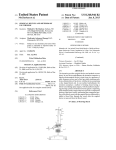






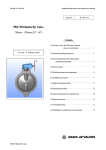



![the file [< 1 MB]](http://vs1.manualzilla.com/store/data/005663565_1-91d1e4bcdfd7b45b626a6b88ab809728-150x150.png)




